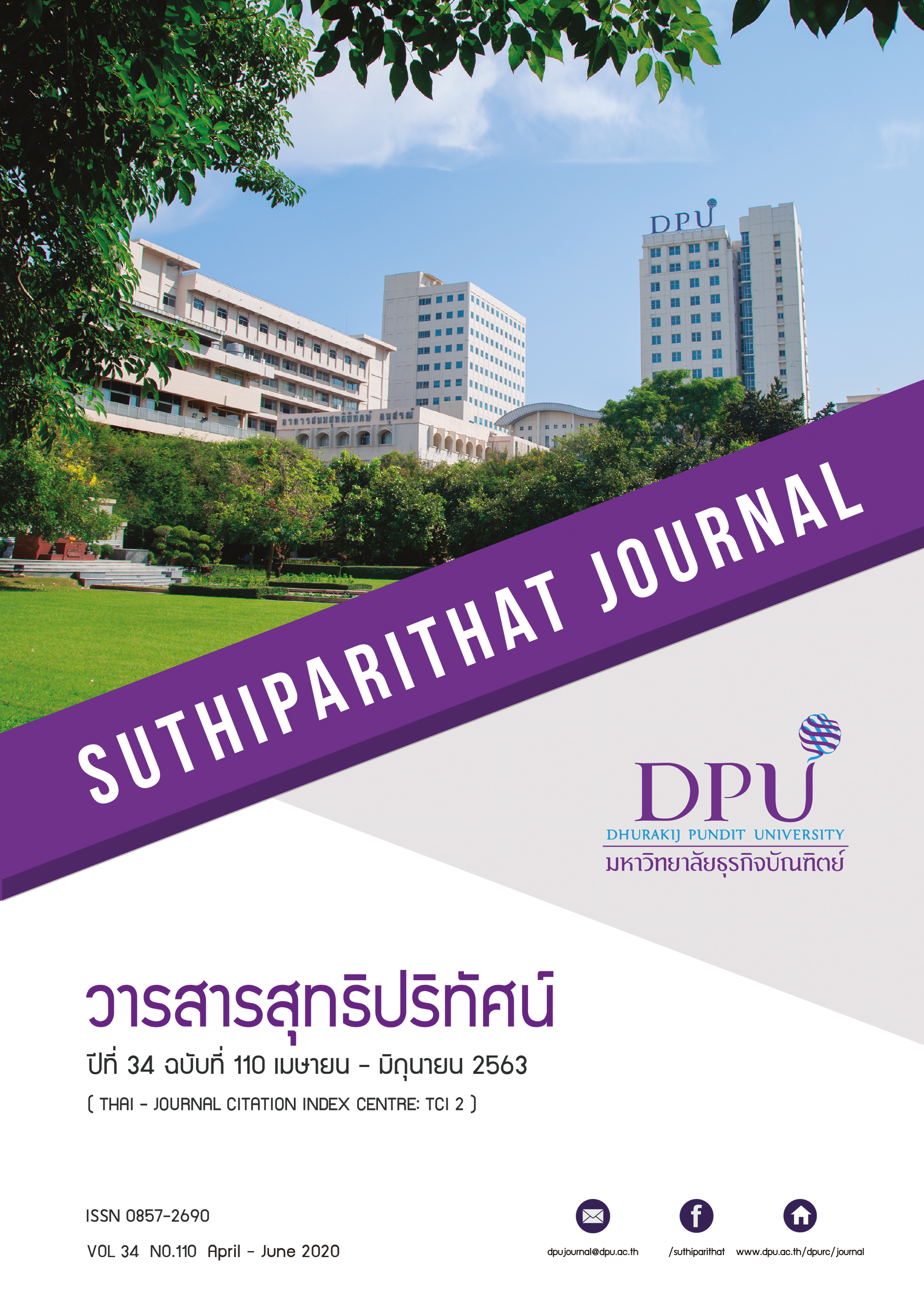การเปิดเผยเรื่องสำคัญในการตรวจสอบ (KAM) และมูลค่าองค์กรตามราคาตลาดของบริษัทจดทะเบียนในตลาดหลักทรัพย์แห่งประเทศไทย
คำสำคัญ:
รายงานของผู้สอบบัญชีรับอนุญาต, เรื่องสำคัญในการตรวจสอบ, มูลค่าองค์กรตามราคาตลาดบทคัดย่อ
เรื่องสำคัญในการตรวจสอบที่ถูกกำหนดให้เปิดเผยไว้ในรายงานของผู้สอบบัญชีรับอนุญาตตามมาตรฐาน การสอบบัญชีถือเป็นสารสนเทศที่เป็นประโยชน์ต่อการตัดสินใจของผู้ใช้ข้อมูล และมีผลกระทบต่อมูลค่าองค์กรตามราคาตลาด งานวิจัยนี้จึงมีวัตถุประสงค์เพื่อศึกษาการเปิดเผยเรื่องสำคัญในการตรวจสอบในรายงานของผู้สอบบัญชีรับอนุญาต และศึกษาความสัมพันธ์ของการเปิดเผยเรื่องสำคัญในการตรวจสอบกับมูลค่าองค์กรตามราคาตลาดของบริษัทจดทะเบียนในตลาดหลักทรัพย์แห่งประเทศ ปี 2559 – 2560 จำนวน 95 บริษัท ผลการศึกษาเกี่ยวกับการเปิดเผย เรื่องสำคัญในการตรวจสอบในรายงานของผู้สอบบัญชีรับอนุญาตพบว่าการรับรู้รายได้เป็นเรื่องที่ถูกเปิดเผยไว้มากที่สุดโดยเลือกใช้วิธีการตรวจเอกสารหลักฐานทางบัญชีและการตรวจทางกายภาพของสินทรัพย์ที่มีตัวตน เหตุผลที่ผู้สอบบัญชีพิจารณาเลือกเรื่องที่นำมาเปิดเผยคือเรื่องที่เกี่ยวข้องกับการประมาณการที่ซับซ้อนของผู้บริหาร โดยระบุข้อมูลที่นำมาอ้างอิงการเปิดเผยเรื่องสำคัญในการตรวจสอบกับหมายเหตุประกอบงบการเงิน ทั้งนี้การนำเสนอข้อมูลในรูปแบบตารางเป็นที่นิยมใช้มากกว่ารูปแบบการบรรยาย ผลการวิเคราะห์ความสัมพันธ์ของการเปิดเผยเรื่องสำคัญใน การตรวจสอบกับมูลค่าองค์กรตามราคาตลาด พบว่าการเปิดเผยเรื่องค่าเผื่อหนี้สงสัยจะสูญและวิธีการขอคำยืนยันยอดมีความสัมพันธ์ในทางบวก โดยที่การเปิดเผยเรื่องการด้อยค่าค่าความนิยมและสินค้าคงเหลือมีความสัมพันธ์ในทางลบ ผลการศึกษาครั้งนี้อาจเป็นประโยชน์ต่อผู้สอบบัญชีเกี่ยวกับการพิจารณาเรื่องสำคัญในการตรวจสอบที่จะนำมาเปิดเผยไว้ในรายงานของผู้สอบบัญชีรับอนุญาต รวมทั้งจะเป็นประโยชน์ต่อหน่วยงานกำกับดูแลในการพิจารณากำหนดแนวทางปฏิบัติสำหรับผู้สอบบัญชีรับอนุญาตและผู้ใช้ข้อมูลในงบการเงินสำหรับการตัดสินใจทางธุรกิจต่อไป
เอกสารอ้างอิง
ชาญชัย ตั้งเรือนรัตน์. (2560). การใช้รายงานของผู้สอบบัญชีแบบใหม่: ประสบการณ์ปีแรก. วารสารวิชาชีพบัญชี, 13(38), 5-21.
นิพันธ์ เห็นโชคชัยชนะ, และศิลปพร ศรีจั่นเพชร. (2559). การสอบบัญชี. กรุงเทพฯ: หจก.ทีพีเอ็น เพรส.
สภาวิชาชีพบัญชีในพระบรมราชูปถัมภ์. (2560). มาตรฐานการสอบบัญชี รหัส 701 เรื่อง การสื่อสารเรื่องสำคัญในการตรวจสอบในรายงานของผู้สอบบัญชีรับอนุญาต. กรุงเทพฯ: สภาวิชาชีพบัญชีในพระบรมราชูปถัมภ์.
สภาวิชาชีพบัญชีในพระบรมราชูปถัมภ์. (2561). เรื่องสำคัญในการตรวจสอบของบริษัทจดทะเบียนสรุปตามอุตสาหกรรมและหัวข้อที่พบบ่อย (พร้อมตัวอย่างของบริษัทในต่างประเทศ). กรุงเทพฯ: บริษัทแอคทีฟพริ้นท์ จำกัด.
Abdolmohammadi, M. J. (1987). Decision support and expert systems in auditing: A review and research directions. Accounting and Business Research, 17(66), 173-185.
Backof, A. (2015). The impact of audit evidence documentation on jurors’ negligence verdicts and damage awards. The Accounting Review, 90(6), 2177–2204.
Backof, A., Bowlin, K., & Goodson, B. (2014). The impact of proposed changes to the content of the audit report on jurors' assessments of auditor negligence. Retrieved from SSRN, 2446057.
Bédard, J., Gonthier-Besacier, N., & Schatt, A. (2014, January). Costs and benefits of reporting key audit matters in the audit report: The French experience. In International Symposium on Audit Research. Retrieved from: https://www.isarhq.org/2014_downloads/ISAR2014_Bedard_Besacier_Schattp.pdf.
Christensen, B. E., Glover, S. M., & Wolfe, C. J. (2014). Do critical audit matter paragraphs in the audit report change nonprofessional investors' decision to invest?. Auditing: A Journal of Practice & Theory, 33(4), 71-93.
Church, B. K., Davis, S. M., & McCracken, S. A. (2008). The auditor’s reporting model: A literature overview and research synthesis. Accounting Horizons, 22(1), 69–90.
Copeland, J. E. (2005). Ethics as imperative. Accounting Horizons, 19(1), 35-43.
Czerney, K., Schmidt, J. J., & Thompson, A. M. (2014b). Does auditor explanatory language in unqualified audit reports indicate increased financial misstatement risk?. The Accounting Review, 89, 2115–2149.
Defliese, P. J., Murray, B., Jaenicke., Henry, R., O’Reilly., & Hirch, P. (1988). Auditing (11th ed.). John Wiley & Sons.
Doxey, M. (2014). The effects of auditor disclosures regarding management estimates on financial statement users’ perceptions and investments. Retrieved from SSRN 2181624.
Elg, U., & Jonnergård, K. (2011). Att träda in i en profession. Om hur kvinnor och män etablerar sig inom revisionsbranschen och akademin. Lund: Business Press.
Fellnäs, V., & Strömbäck, J. (2015). Key audit matters-en studie i dess värde för privata investerare. Retrieved from https://lup.lub.lu.se/student-papers/search/publication/7455470.
Fleishman, E. A. (1975). Toward a taxonomy of human performance. American Psychologist, 30(12), 1127.
Gill, G. S., Cosserat, J., Leung, P., & Coram, P. (1999). Modern auditing (5th ed.). Australia: John Wiley & Sons.
Gill, G. S., Cosserat, J., Leung, P., & Coram, P. (2001). Modern auditing and assurance services (6th ed.). Australia: John Wiley & Sons.
Gordos, G. S., & Fulop, M. T. (2015). Understanding audit reporting changes: Introduction of key audit matters. Accounting and Management Information Systems, 14, 128-152.
Gutierrez, E., Minutti-Meza, M., Tatum, K. W., & Vulcheva, M. (2016). Consequences of changing the auditor’s report: Evidence from the UK. Social Science Research Network. Retrieved from SSRN 2741174.
IAASB. (2013). A framework for audit quality: Consultation paper. Retrieved from https://www.iaasb.org/publications-resources/framework-audit-quality
IAASB. (2015). Auditor reporting – Key audit matters. IFAC. Retrieved from http://www.ifac.org/sites/default/files/publications/files/Auditor-Reporting-Toolkit-KAMOverview.pdf
IODAS. (2015). The impact of the new auditors report. Retrieved from http//www.iodas.co.za/now/241065.
Kastein, P., & Saad, S. (2013). White paper on the auditor’s reports of certain UK companies that comply with International Auditing Standard (UK and Ireland) 700 (Revised June 2013). Retrieved from https://pcaobus.org/Rulemaking/Docket034/white-paper-on-the-auditor-reports-of-certain-UK-Companies-that-Comply-with-International-auditing-standard.pdf
Kelly, A. S., & Mohrweis, L. C. (1986). Bankers' and investors' perceptions of the auditor's role in financial statement reporting: The impact of SAS No. 58. Auditing: A Journal of Practice & Theory, 9(1), 87.
Knechel, W. R., Salterio, E., & Brian B. (2007). Auditing: Assurance and risk (3rd ed.). Mason: Thomson South-Western.
Lennox, C. S., Schmidt, J. J., & Thompson, A. (2018). Is the expanded model of audit reporting informative to investors? Evidence from the UK (June 18, 2018). Retrieved from SSRN 2619785.
Liang, S. L. (2016). Spillover effect of disclosure regulation: Evidence from audit report changes in the UK (Doctoral dissertation). Country: Impel Temple University Libraries
Libby, R. (1979). Bankers' and auditors' perceptions of the message communicated by the audit report. Journal of Accounting Research, 17(1), 99-122.
Mayer, R. E., & Moreno, R. (2003). Nine ways to reduce cognitive load in multimedia learning. Educational Psychologist, 38(1), 43-52.
Norris, F. (2014). Holding auditors accountable on reports. The New York Times. Retrieved from https://www.nytimes.com/2014/05/09/business/holding-auditors-accountable.html
Kastein, P., & Siddiqui, S. (2017). White paper on the auditor’s reports of certain UK companies that comply with international auditing standard (UK and Ireland) 700 (Revised June 2013).
Porter, B., Ó hÓgartaigh, C., & Baskerville, R. (2009). Report on research conducted in the United Kingdom and New Zealand in 2008 investigating the audit expectation-performance gap and users' understanding of, and desired improvements to, the auditor's report. Understanding of, and Desired Improvements to, the Auditor’s Report’. Report prepared for IFAC. Retrieved from https://www.ifac.org/system/files/downloads/Porter_et_al_Final_Report_Combined.pdf
Pound, G., Willingham, J., & Carmichael, B. (1997). Auditing concepts and methods (3rd ed.). Australia: The McGraw Hill.
Reid, L. C., Carcello, J. V., Li, C., & Neal, T. L. (2015). Impact of auditor and audit committee report changes on audit quality and costs: Evidence from the United Kingdom. Retrieved from SSRN 2647507.
Robertson, J. C., & Davis, F. (2004). Auditing (5th ed.). Texas, USA: Business Publications. Salehi M, Mansouri.
A., & Azary, Z. (2009). Independence and audit expectation gap: Empirical evidence from Iran. Int. J. Econ. Financ., 1(1), 165-174.
Sirois, L., Bédard, J., & Bera, P. (2015). The informational value of key audit matters in the auditor’s report: Evidence from an eye-tracking study. Working paper, HEC Montreal, Université Laval, and Saint Louis University.
Smith, K. (2019). Tell me more: a content analysis of expanded auditor reporting in the United Kingdom. Retrieved from SSRN 2821399.
Touche, W. (2014). PCAOB public meeting on the auditor's reporting model. Retrieved from http://pcaobus.org/Rules/Rulemaking/Docket034/04032014Transcript.pdf.
Wyman, P. (2004). Is auditor independence really the solution?. The CPA Journal, 74(4), 6.
ดาวน์โหลด
เผยแพร่แล้ว
รูปแบบการอ้างอิง
ฉบับ
ประเภทบทความ
สัญญาอนุญาต
เนื้อหาและข้อมูลในบทความที่ลงตีพิมพ์ในวารสารสุทธิปริทัศน์ ถือเป็นข้อคิดเห็นและความรับผิดชอบของผู้เขียนบทความโดยตรงซึ่งกองบรรณาธิการวารสาร ไม่จำเป็นต้องเห็นด้วย หรือร่วมรับผิดชอบใด ๆ
บทความ ข้อมูล เนื้อหา รูปภาพ ฯลฯ ที่ได้รับการตีพิมพ์ในวารสารสุทธิปริทัศน์ ถือเป็นลิขสิทธิ์ของวารสารสุทธิปริทัศน์หากบุคคลหรือหน่วยงานใดต้องการนำทั้งหมดหรือส่วนหนึ่งส่วนใดไปเผยแพร่ต่อหรือเพื่อกระทำการใด ๆ จะต้องได้รับอนุญาตเป็นลายลักษณ์อักษรจากวารสารสุทธิปริทัศน์ก่อนเท่านั้น







